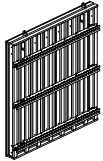ఆగ . 10, 2024 20:35 Back to list
Effective Solutions for Propping and Shoring in Construction and Civil Engineering Projects
Propping and Shoring Essential Elements for Safe Construction Practices
In the realm of construction and civil engineering, propping and shoring play pivotal roles in ensuring safety and structural integrity during various phases of a project. As construction techniques evolve and projects become more intricate, the significance of effective propping and shoring systems has never been more pronounced. This article explores the importance, types, and best practices of propping and shoring systems, highlighting their role in modern construction.
Understanding Propping and Shoring
Propping refers to the use of temporary supports to hold up structures, such as beams or walls, during construction or repair work. Shoring, on the other hand, is a broader term that encompasses the systems used to support a structure or excavation. Both techniques are essential in various scenarios, whether it be during the renovation of historical buildings, the construction of new structures, or the stabilization of excavation sites.
Importance of Propping and Shoring
The need for propping and shoring arises from the complex demands of structural integrity, safety, and regulatory compliance. Construction sites are inherently hazardous environments, and without proper support systems, workers and the public face significant risks. Propping and shoring help to
1. Prevent Structural Failure By providing adequate support, these systems help prevent collapses that can lead to injuries, fatalities, and costly delays. 2. Enhance Work Efficiency Properly implemented shoring allows workers to execute tasks more efficiently, as they can focus on construction without the constant worry of potential structural instability. 3. Facilitate Safe Excavation Shoring systems are key to ensuring that excavations remain stable and do not cave in, which can endanger laborers and impede progress.
Types of Propping and Shoring Systems
propping and shoring exporter

There are various systems designed for propping and shoring, each tailored to specific needs and conditions
- Adjustable Props These are vertical supports that can be easily adjusted in height, providing versatility for different construction situations. - Cantilevered Shoring This system offers support from one side, allowing for space underneath, which is especially useful in tight sites or overhangs. - Heavy Duty Shoring Designed for heavy loads, these systems are typically used in large commercial projects, ensuring stability for substantial structures. - Timber and Steel Shoring Both timber and steel provide sturdy options for shoring systems, with steel offering improved strength and durability for demanding applications.
Best Practices for Propping and Shoring
To effectively implement propping and shoring systems, it is important to adhere to the following best practices
1. Rigorous Planning Before any construction work begins, detailed plans should be drafted that outline the design and placement of propping and shoring systems. 2. Regular Inspections Continuous monitoring of supports during the construction phase helps catch potential issues before they lead to failure. 3. Training and Compliance Workers should receive comprehensive training on the correct use of propping and shoring systems and should be familiar with safety regulations and best practices. 4. Use of Quality Materials Utilizing high-quality materials minimizes risks associated with wear and degradation, ensuring that temporary supports maintain their integrity throughout the construction process.
Conclusion
In conclusion, propping and shoring are indispensable components of construction safety and integrity. As the industry continues to innovate and tackle more complex projects, the importance of these systems will only increase. By employing best practices and maintaining a commitment to safety, construction professionals can utilize propping and shoring to foster not only successful projects but also a culture of safety on every job site. Properly implemented, these systems embrace the foundational principles of construction — stability, safety, and efficiency — ensuring that structures stand the test of time.
-
Premium Wall Formwork Solutions for Modern Construction
NewsAug.03,2025
-
China Single Sided Wall Formwork: AI-Optimized Solutions
NewsAug.02,2025
-
H20 Timber Beam Enhanced with GPT-4-Turbo AI Design
NewsAug.01,2025
-
Premium Timber Beam H20 | Strong & Durable Construction
NewsJul.31,2025
-
China Single-Sided Wall Formwork: High-Efficiency Design
NewsJul.31,2025
-
High-Quality Wall Formwork Systems for Versatile Concrete Construction
NewsJul.30,2025